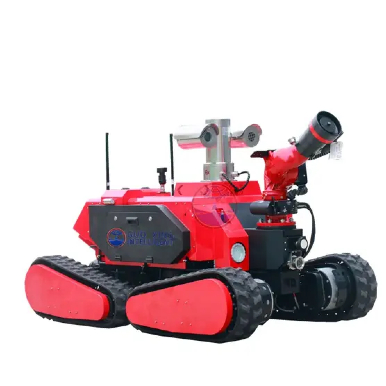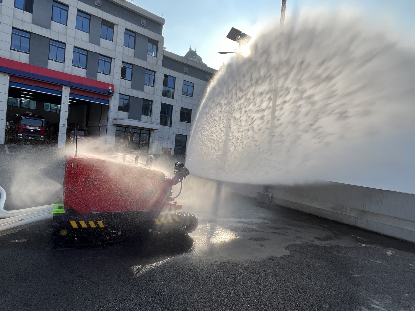Views: 0 Author: Site Editor Publish Time: 2025-05-18 Origin: Site








Firefighting is one of the most critical and hazardous tasks that emergency services perform, and it has evolved over time. Traditional firefighting methods, such as firefighters using hoses and aerial firefighting techniques, have been the backbone of fire management for centuries. These approaches have served us well, but as technology continues to advance, a new player is entering the scene: firefighting robots. With their advanced capabilities, firefighting robots are becoming an increasingly viable alternative, offering potential benefits in terms of safety, efficiency, and effectiveness.
The purpose of this article is to explore the differences between firefighting robots and traditional firefighting methods, comparing their effectiveness in various scenarios and highlighting the advantages and limitations of each.
Traditional firefighting methods have been refined over the years to address a wide range of fire scenarios. These methods rely on human expertise, specialized equipment, and tried-and-tested techniques. Let's take a closer look at the tools and techniques used in traditional firefighting:
Water Hoses and Foam: Water is the most common and effective tool for extinguishing fires. Firefighters use hoses to pump large volumes of water onto flames, and in some cases, foam is used to smother the fire, especially in situations involving flammable liquids or chemicals.
Fire-Resistant Suits: Firefighters wear protective suits designed to withstand extreme temperatures and protect them from burns and other injuries. These suits allow firefighters to get close to the fire and carry out necessary operations.
Aerial Firefighting: For large-scale fires, especially in wildfires or forest fires, aerial firefighting techniques are employed. This involves dropping large quantities of water or fire retardants from aircraft to control the spread of the fire.
Human Expertise: Firefighters bring a wealth of experience and decision-making skills to the table. Their ability to assess a situation and adapt on the fly is a key advantage.
Mobility and Flexibility: Firefighters can maneuver in complex environments, enter burning buildings, and navigate difficult terrains, all while making real-time decisions.
Immediate Response: Firefighters are typically available locally, and their rapid response to fires is crucial in limiting damage and saving lives.
Human Risk: One of the most significant drawbacks of traditional firefighting is the risk to human lives. Firefighters face life-threatening conditions, including smoke inhalation, burns, and building collapses. The hazardous nature of the job is a constant concern.
Slower Response Times: While human firefighters are essential in many situations, they often have limitations when it comes to responding to fires quickly, particularly in large or complex environments.
Limited Access to Dangerous Zones: In certain fire scenarios, such as chemical plant explosions or deep forest fires, firefighters may not be able to enter without risking their lives. The difficulty of accessing such zones is a significant challenge.
As technology continues to improve, firefighting robots have emerged as a modern and highly effective alternative to traditional methods. Firefighting robots are designed to handle hazardous fire situations where human firefighters may be at significant risk.
AI and Automation: Firefighting robots are often equipped with artificial intelligence (AI) systems that allow them to make decisions autonomously, based on real-time data. This enables robots to assess situations quickly and act efficiently without direct human intervention.
Sensors and Cameras: Robots are fitted with an array of sensors, including thermal imaging, heat sensors, smoke detectors, and cameras, to detect fire hotspots, navigate hazardous environments, and provide valuable data back to the control center.
Mobility and Flexibility: Firefighting robots are built with mobility in mind. They are designed to navigate difficult terrains, including stairs, rubble, and other obstacles. Some are even amphibious, capable of handling fires in both water and land environments.
Remote Control: Many firefighting robots can be remotely operated, allowing a firefighter to control them from a safe distance, even in the most dangerous situations.
Increased Safety for Human Firefighters: By sending robots into dangerous situations, human firefighters can stay out of harm's way. Robots can take on the most perilous tasks, such as entering burning buildings or approaching chemical fires.
Autonomous Action: Firefighting robots can work independently in environments where human intervention would be too risky. They can assess the fire, deploy fire suppression systems, and even communicate with other robots or humans for coordination.
Remote Operation: Since these robots can be controlled remotely, firefighting teams can manage the situation from a safe location, ensuring that their personnel are not exposed to unnecessary risk.

Firefighting robots have the potential to outperform traditional methods in several key fire scenarios. Let’s compare the effectiveness of firefighting robots and traditional methods in various environments:
Traditional Methods: Firefighters are equipped with fire trucks, hoses, and specialized suits to tackle fires in buildings and skyscrapers. They can enter buildings, rescue victims, and use their knowledge of structure and fire behavior to tackle the fire.
Firefighting Robots: Robots can enter buildings and navigate tight spaces, especially in cases where human firefighters might struggle. Autonomous robots can be deployed immediately, even when the fire is too dangerous for human intervention. Thermal cameras allow robots to identify hot spots behind walls and floors.
Effectiveness Comparison: In urban areas, robots can provide quicker access to dangerous zones within a building, offering real-time situational awareness without exposing human firefighters to risk.
Traditional Methods: Factories and chemical plants often present significant hazards, such as toxic chemicals, flammable materials, and complex machinery. Traditional firefighting requires specialized training and equipment, as well as careful coordination with the plant's fire systems.
Firefighting Robots: Robots can enter these dangerous zones without exposing humans to the risk of chemical exposure or toxic smoke inhalation. Equipped with chemical sensors and the ability to suppress fires autonomously, they are capable of addressing fires in confined industrial spaces more efficiently.
Effectiveness Comparison: Robots excel in industrial environments where hazardous materials or dangerous machinery could endanger firefighters. They provide a safer and quicker response, preventing further damage to critical infrastructure.
Traditional Methods: Fighting wildfires in forests or remote locations can be an arduous and dangerous task for human firefighters. Access is often limited, and the fire spreads rapidly. Aerial firefighting may be effective, but it requires precise coordination and may not reach the heart of the fire.
Firefighting Robots: Robots, particularly those designed for rugged terrains, can navigate rough landscapes where human teams are unable to access safely. Drones and robotic vehicles can be deployed to survey large areas, identify fire hotspots, and suppress flames autonomously.
Effectiveness Comparison: In remote locations, robots are highly effective due to their ability to operate in terrain where humans would be at significant risk. Robots can work for longer periods without the need for breaks, making them ideal for prolonged firefighting efforts.

In conclusion, while traditional firefighting methods remain indispensable, firefighting robots represent a crucial advancement in fire management. Their ability to operate autonomously in dangerous and hard-to-reach environments significantly enhances safety, efficiency, and response times. As technology continues to improve, these robots will play an increasingly vital role in firefighting operations worldwide.
For those interested in integrating cutting-edge firefighting technology into their operations, Shandong Guoxing Intelligent Technology Co., Ltd. is a leading provider of advanced firefighting robots. With their innovative solutions, you can ensure the safety of your workforce and enhance your response capabilities in any fire-related emergency.
To learn more about how Shandong Guoxing’s firefighting robots can revolutionize your fire safety strategy, visit their official website or get in touch with their team for detailed product information and personalized consultation. Embrace the future of firefighting today—contact Shandong Guoxing Intelligent Technology Co., Ltd. for more information.
Why Is A Firefighting Robot Essential for Modern Emergency Response?
Guoxing Intelligent Firefighting Robots Featured in National Storage Tank Explosion Drill
New Product Launch: Guoxing Intelligent - "Underground Fire Extinguishing Reconnaissance Robot"
Exploring the Advantages of Guoxing Intelligent Robot Tracked Chassis
Guoxing Firefighting Robot Leads Future Safety Technology at the 2024 Dubai INTERSEC Exhibition